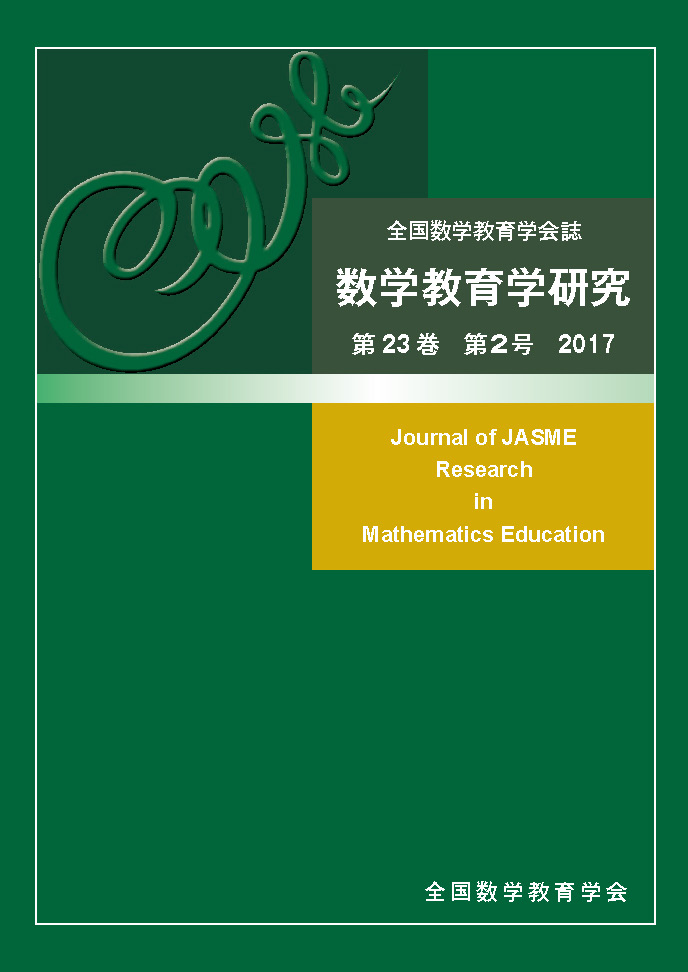Volume 23, Issue 2
Journal of JASME Research in Mathematics Education
Displaying 1-17 of 17 articles from this issue
- |<
- <
- 1
- >
- >|
-
2017 Volume 23 Issue 2 Pages 1-13
Published: July 31, 2017
Released on J-STAGE: September 09, 2019
Download PDF (558K) -
2017 Volume 23 Issue 2 Pages 15-29
Published: July 31, 2017
Released on J-STAGE: September 09, 2019
Download PDF (1466K) -
2017 Volume 23 Issue 2 Pages 31-45
Published: July 31, 2017
Released on J-STAGE: September 09, 2019
Download PDF (1398K) -
2017 Volume 23 Issue 2 Pages 47-59
Published: July 31, 2017
Released on J-STAGE: September 09, 2019
Download PDF (1278K) -
2017 Volume 23 Issue 2 Pages 61-72
Published: July 31, 2017
Released on J-STAGE: September 09, 2019
Download PDF (905K) -
2017 Volume 23 Issue 2 Pages 73-82
Published: July 31, 2017
Released on J-STAGE: September 09, 2019
Download PDF (491K) -
2017 Volume 23 Issue 2 Pages 83-90
Published: July 31, 2017
Released on J-STAGE: September 09, 2019
Download PDF (567K) -
2017 Volume 23 Issue 2 Pages 91-103
Published: July 31, 2017
Released on J-STAGE: September 09, 2019
Download PDF (395K) -
2017 Volume 23 Issue 2 Pages 105-116
Published: July 31, 2017
Released on J-STAGE: September 09, 2019
Download PDF (532K) -
2017 Volume 23 Issue 2 Pages 117-128
Published: July 31, 2017
Released on J-STAGE: September 09, 2019
Download PDF (429K) -
2017 Volume 23 Issue 2 Pages 129-140
Published: July 31, 2017
Released on J-STAGE: September 09, 2019
Download PDF (627K) -
2017 Volume 23 Issue 2 Pages 141-149
Published: July 31, 2017
Released on J-STAGE: September 09, 2019
Download PDF (537K) -
2017 Volume 23 Issue 2 Pages 151-158
Published: July 31, 2017
Released on J-STAGE: September 09, 2019
Download PDF (398K) -
2017 Volume 23 Issue 2 Pages 159-168
Published: July 31, 2017
Released on J-STAGE: September 09, 2019
Download PDF (830K) -
Article type: research-article
2017 Volume 23 Issue 2 Pages 169-177
Published: July 31, 2017
Released on J-STAGE: September 09, 2019
Download PDF (438K) -
Article type: oration
2017 Volume 23 Issue 2 Pages 179-180
Published: July 31, 2017
Released on J-STAGE: September 09, 2019
Download PDF (276K) -
Article type: oration
2017 Volume 23 Issue 2 Pages 181-182
Published: July 31, 2017
Released on J-STAGE: September 09, 2019
Download PDF (218K)
- |<
- <
- 1
- >
- >|
